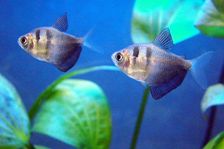Black Tetra
(Gymnocorymbus Ternetzi)
Alternate Names:
Black Skirt Tetra
Black Widow Tetra
Butterfly Tetra
Gold Skirt Tetra
Blueberry Tetra (Dyed)
Glofish Tetra (Genetically Altered)
 Black Tetra (Gymnocorymbus Ternetzi) |
Size: Can grow to 2.5 Inches Temp Range: 68°F to 80°F pH Level: 6.5 to 7.0 Lifespan: 5 to 6 years Tank Size: 20 gallons Diet: Pellet, Flake, Frozen Difficulty: Moderate |
Geographic History
These very common aquarium fish are originally from Paraguay. They may also be found in the Guapore River basin of Southern Brazil, Argentina, and Bolivia.
Enviornment
The Black Tetra loves to swim across a long tank with plants along the sides and rear. You should keep the water current slow. They also like to have low light level or light that shines through floating plants.
Compatibility
These social little fish like to hang out in groups of six or more. They are a beautiful addition to most community tanks. Take care to avoid putting them in aquariums with long finned fish as they tend to fin nip, especially in smaller numbers.
Sexing
Female Black Tetra are larger than males and have a more bulbous belly. Males have wider anal fins and a more pointed, narrow dorsal fin.
Behavior
Shoaling happens with these little guys when they are in groups of six or more. They are a generally peaceful and active swimming fish, but will fin nip in groups smaller than six. They spend a lot of time chasing each other in the open middle area of the tank.
Breeding
Black Tetras reach sexual maturity at around two years of age. To make the most out of your quick little friends' spawning behavior, move a group of six females and six males to a twenty gallon breeding tank. Add marbles to this tank for substrate and the eggs will fall into spaces that the adults cannot reach. Small clumps of plants should be scattered around the bottom of the aquarium.
The females will move from plant cluster to plant cluster depositing eggs, being followed closely by the males. Once the eggs are deposited in and near the plants, they will fall into the marble substrate. After spawning occurs, remove all the adults.
Fry should be fed crushed flake and Inforusia. Make sure to keep excellent water quality throughout the spawning and growth of the fry. When they become juveniles they are more hardy, like their parrents.
For more information, go to Wikipedia's Black Tetra page.





